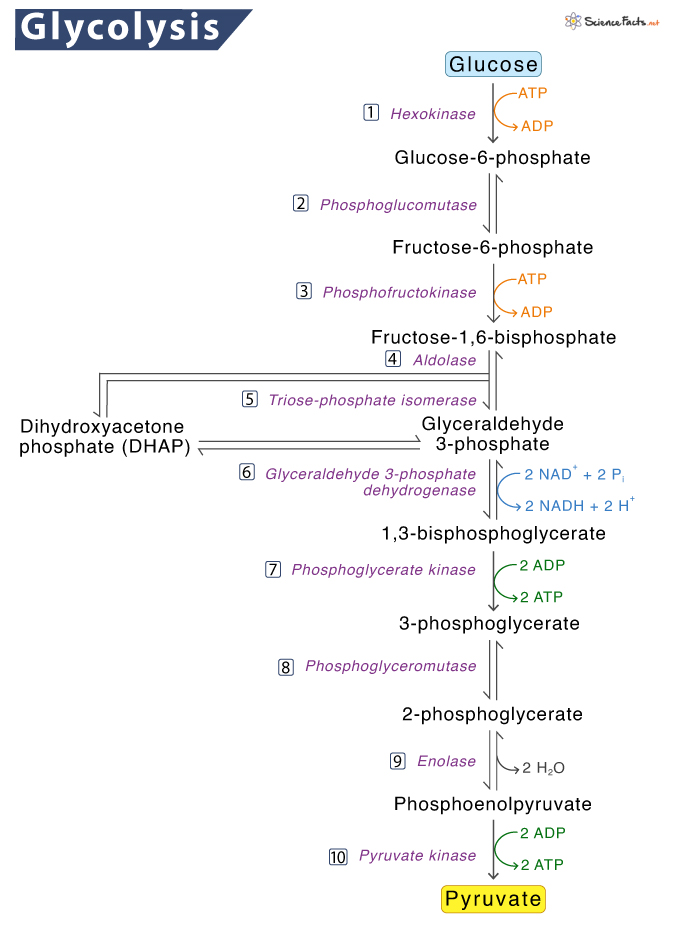Glycolysis
Glycolysis is the first and common step for aerobic and anaerobic cellular respiration. ‘Glyco’ stands for ‘glucose’, and ‘lysis’ means ‘splitting’. So, it can be defined as a metabolic process where a glucose molecule gets broken down under the influence of several enzymes. Here, the six-carbon compound glucose splits into two molecules of pyruvate, a three-carbon sugar. Along with pyruvate, the process also yields 2 ATPs, 2 NADH, and 2 H2O.
This metabolic pathway is also known as Embden–Meyerhof–Parnas pathway or EMP pathway after its discoverer German biochemists Gustav Embden, Otto Meyerhof, and Jakub Karol Parnas.
Location: Where Does Glycolysis Occur
In both prokaryotic (e.g. bacteria) and eukaryotic cells (e.g. all higher animals) glycolysis takes place in the cytoplasm.
Steps: Glycolysis Pathway
Glycolysis mainly occurs through these 10 following steps:
Step 1: In the first step, a phosphate group from ATP gets transferred to the glucose molecule present in the cell cytoplasm, producing glucose-6-phosphate. This step is catalyzed by the enzyme hexokinase.
Step 2: Next, the glucose-6-phosphate gets converted into its isomer, fructose-6-phosphate by the action of phosphoglucomutase.
Step 3: Another phosphate group gets transferred from ATP to fructose-6-phosphate to produce fructose-1,6-bisphosphate, under the influence of phosphofructokinase.
Step 4: In this step, the enzyme aldolase acts on the fructose-1,6-bisphosphate and splits it into dihydroxyacetone phosphate (DHAP) and glyceraldehyde 3-phosphate. These two three-carbon molecules are isomers of each other. Out of them, only glyceraldehyde-3-phosphate can directly continue through the next steps of glycolysis.
Step 5: As DHAP cannot directly take part in the consecutive steps of the process, it gets converted into its isomer glyceraldehyde-3-phosphate by the enzyme triose-phosphate isomerase.
Step 6: Next, the enzyme glyceraldehyde 3-phosphate dehydrogenase (GAPDH) adds a phosphate from the cytosol to the glyceraldehyde 3-phosphate to form 1,3-bisphosphoglycerate. The same enzyme also dehydrogenates glyceraldehyde 3-phosphate by transferring one of its hydrogen (H⁺) molecules to the oxidizing agent NAD⁺ to form NADH and H⁺. The two molecules of glyceraldehyde 3-phosphate, one formed directly and one after the interconversion, both undergo this process of phosphorylation and dehydrogenation.
Step 7: After this, the 1,3-bisphosphoglycerate donates one of its phosphate groups to ADP, making a molecule of ATP and turning into 3-phosphoglycerate (3 PGA) in the process. As there are two molecules of 1,3-bisphosphoglycerate, the reaction yields two 3 PGA, and 2 ATPs.
Step 8: 3-phosphoglycerate gets converted into its isomer, 2-phosphoglycerate by the action of phosphoglyceromutase.
Step 9: In this step, the enzyme enolase acts on 2-phosphoglycerate and removes a molecule of water from it, thus producing phosphoenolpyruvate (PEP).
Step 10: As PEP is an unstable molecule, it loses one of its phosphate group in this step. The lost phosphate group gets to ADP under the influence of the enzyme pyruvate kinase. This step yields 2 molecules of pyruvate and 2 ATPs in the end. As this pyruvate enters the next phase of cellular respiration, it is considered as the end product of glycolysis.
Equation
C6H12O6 + 2NAD+ +2ADP + 2Pi → 2C3H4O3 + 2NADH + 2ATP + 2H+ + 2H2O
Reactants
- Glucose (C6H12O6)
- Nicotinamide adenine dinucleotide, oxidized (NAD+)
- Adenosine diphosphate (ADP)
- Inorganic phosphate (Pi)
Products
- Pyruvate (C3H4O3)
- Nicotinamide adenine dinucleotide, reduced (NADH)
- Adenosine triphosphate (ATP)
- Water (H2O)
Phases of Glycolysis
The overall process of glycolysis can be classified into two main phases: energy-requiring or energy investment phase, and energy-releasing or energy payoff phase.
i. Energy investment phase – This phase includes the steps that require energy in the form of ATPs. In glycolysis, two ATP molecules are required to produce high energy intermediates.
ii. Energy payoff phase – Contrary to the the previous step, here ATP molecules are released as the byproducts of the pathway. The overall reaction yields 4 ATPs, and 2 NADH molecules.
Total ATP Yield
Though a total of 4 ATP molecules are produced in the process, 2 are consumed in the process itself. So, the net number of ATPs produced in glycolysis is 2.
Function
- It breaks down glucose to form high-energy molecules ATP and NADH, which fuel the cellular activities.
- Pyruvate, the end product of this process, helps to continue the chain reactions of cellular respiration. In aerobic respiration it enters the citric acid cycle, whereas in anaerobic respiration it takes part in fermentation.
- The intermediate compounds formed in this process can be used in various other cellular processes.
Advantage
The main advantage of glycolysis is that it produces energy very fast, without requiring oxygen.
FAQs
Ans: Yes, glycolysis can occur without oxygen.
Ans: No, glycolysis does not produce CO2.
Ans: Yes, glycolysis occur before Krebs cycle.
Ans: Yes, glycolysis occurs in all living cells.
Ans: ATP is required to split the glucose molecule into two pyruvate molecules.
-
References
Article was last reviewed on Wednesday, October 4, 2023




